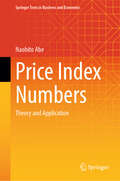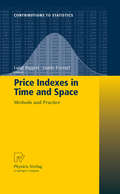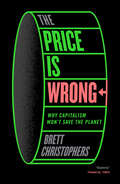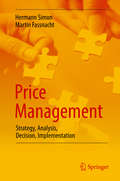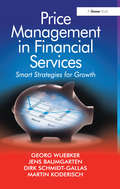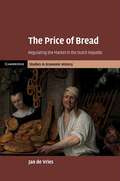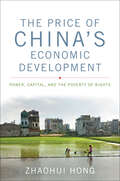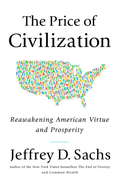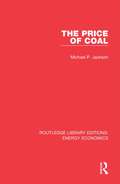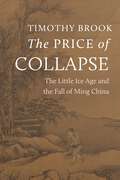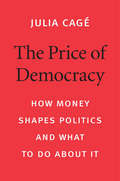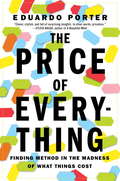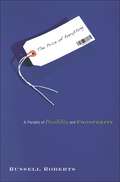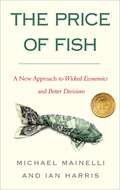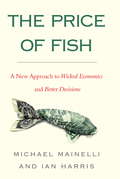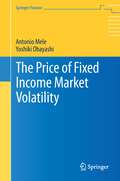- Table View
- List View
Price-Fixing Vignettes
by Michelle Kalka Guhan SubramanianThis case escribes the antitrust prosecutions in the United States and abroad of the international bulk vitamins cartel. Both the civil and criminal fines were historically high, and it was the first time the United States prosecuted foreign nationals for U.S. criminal antitrust charges. It also details allegations of price-fixing by NASDAQ securities traders, which began when an academic paper accused NASDAQ market makers of avoiding quotes with odd-numbered increments. The remaining vignette provides an account of the price-fixing scandal involving Christie's and Sotheby's fine-art auction houses.
Price Imputation and Other Techniques for Dealing with Missing Observations, Seasonality and Quality Change in Price Indices
by Paul A Armknecht Fenella Maitland-SmithA report from the International Monetary Fund.
The Price Index and its Extension: A Chapter in Economic Measurement
by Sydney N. AfriatThe book is not an unrestricted survey engaging a vast and repetative literature, but a systematic treatise within clear boundaries, largely a document of Afriat's own work. The original motive of the work is to elaborate a concept of what really is a price index, which, despite some kind of price-level notion having a presence throughout economics
Price Index Concepts and Measurement
by W. Erwin Diewert John Greenlees Charles R. HultenAlthough inflation is much feared for its negative effects on the economy, how to measure it is a matter of considerable debate that has important implications for interest rates, monetary supply, and investment and spending decisions. Underlying many of these issues is the concept of the Cost-of-Living Index (COLI) and its controversial role as the methodological foundation for the Consumer Price Index (CPI). Price Index Concepts and Measurements brings together leading experts to address the many questions involved in conceptualizing and measuring inflation. They evaluate the accuracy of COLI, a Cost-of-Goods Index, and a variety of other methodological frameworks as the bases for consumer price construction.
Price Index Numbers: Theory and Application (Springer Texts in Business and Economics)
by Naohito AbeThis textbook offers a comprehensive yet concise introduction to the theory behind price indices, covering the basics, historical background, necessary mathematical foundations, and contemporary cutting-edge theories. For those looking to study price indices, the most commonly used resources have traditionally been the comprehensive but voluminous CPI Manual, which is aimed at statistical practitioners, or Balk (2008), which, while covering theory concisely, requires advanced mathematical skills. This book is distinctive in that it (1) places emphasis on the relationship between price indices and economic theory, (2) presents cutting-edge methods and topics such as multilateral indices using scanner data and price measurement using Engel curves, and (3) provides explanations of essential mathematical techniques like functional equations, thus enabling self-study from the fundamentals to the forefront of modern index number theory.
Price Indexes in Time and Space: Methods and Practice
by Luigi Biggeri Guido FerrariThis book deals with the currently most relevant topics in price index numbers theory and practice. The problem of the harmonization of Consumer Price Indexes (CPIs) and the time-space integration of baskets is analyzed at the EU-zone level, with methodological and practical proposals on how to proceed for an overall treatment of the matter. Another issue is comparisons between Purchasing Power Parities (PPPs) and CPIs. Likewise, the construction of sub-indexes for households, economic and social groups is investigated, in order to obtain specific inflation measurement instruments. The book provides evidence from the most updated databases. Among the other issues treated in this book are spatial comparisons of price levels through PPPs and the international comparisons of macroeconomic aggregates, a re-consideration of index numbers theory, the measurement of production in non-market services, deflation problems, and price indexes in financial markets.
The Price is Wrong: Why Capitalism Won't Save the Planet
by Brett Christophers"Standard theories of the causes of climate breakdown will not survive this book. Readers will be all the wiser."—Andreas Malm, author of How to Blow Up a PipelineWhy the market will never solve the climate crisisWhat if our understanding of capitalism and climate is back to front? What if the problem is not that transitioning to renewables is too expensive, but that saving the planet is not sufficiently profitable?This is Brett Christophers' claim. The global economy is moving too slowly toward sustainability because the return on green investment is too low.Today's consensus is that the key to curbing climate change is to produce green electricity and electrify everything possible. The main economic barrier in that project has seemingly been removed. But while prices of solar and wind power have tumbled, the golden era of renewables has yet to materialize.The problem is that investment is driven by profit, not price, and operating solar and wind farms remains a marginal business, dependent everywhere on the state's financial support.We cannot expect markets and the private sector to solve the climate crisis while the profits that are their lifeblood remain unappetizing. But there is an alternative to providing surrogate green profits through subsidies: to take energy out of the private sector's hands.An essential intervention, The Price Is Wrong is as politically far-reaching as it is factually illuminating.
Price Liberalization in Russia
by Vincent Koen Steven PhillipsPrices in the Russian Federation have been decontrolled in several steps since early 1991, after decades of near fixity. This paper documents and analyzes the behavior of prices, income, consumption, and savings before and after the January 1992 price liberalization, with emphasis on developments during 1992, and with focus on households more than on enterprises. Comparisons are made with recent experience in Central and Eastern Europe, along with consideration of evidence on shortages and income distribution.
Price Management: Strategy, Analysis, Decision, Implementation
by Hermann Simon Martin FassnachtIn this book, the world’s foremost experts on pricing integrate theoretical rigor and practical application to present a comprehensive resource that covers all areas of the field. This volume brings together quantitative and qualitative approaches and highlights the most current innovations in theory and practice. Going beyond the traditional constraints of “price theory” and “price policy,” the authors coined the term “price management” to represent a holistic approach to pricing strategy and tactical implementation. They remind us that the Ancient Romans used one word, pretium, to mean both price and value. This is the fundamental philosophy that drives successful price management where producer and customer meet. Featuring dozens of examples and case studies drawn from their extensive research, consulting, and teaching around the world, Simon and Fassnacht cover all aspects of pricing following the price management process with its four phases: strategy, analysis, decision, and implementation. Thereby, the authors take into account the nuances across industry sectors, including consumer goods, industrial products, services, and trade/distribution. In particular, they address the implications of technological advancements, such as the Internet and new measurement and sensor technologies that have led to a wealth of price management innovations, such as flat rates, freemium, pay-per-use, or pay-what-you-want. They also address the emergence of new price metrics, Big Data applications, two-sided price systems, negative prices, and the sharing economy, as well as emerging payment systems such as bitcoin. The result is a “bible” for leaders who recognize that price is not only a means to drive profit in the short term, but a tool to generate sustained growth in shareholder value over the longer term, and a primer for researchers, instructors, and students alike.Praise for Price Management“This book is truly state of the art and the most comprehensive work in price management.” - Prof. Philip Kotler, Kellogg School of Management, Northwestern University “This very important book builds an outstanding bridge between science and practice.“ - Kasper Rorsted, CEO, Adidas “This book provides practical guidelines on value creation, communication and management, which is an imperative for businesses to survive in the coming era of uncertainty.” - Dr. Chang-Gyu Hwang, Chairman and CEO, KT Corporation (Korea Telecom)
Price Management in Financial Services: Smart Strategies for Growth
by Georg Wuebker Jens Baumgarten Martin KoderischThe financial services industry is undergoing a period of dramatic change. Deregulation has created an ultra-competitive marketplace and recent challenges like the worldwide subprime crisis, SEPA and Basel II have only intensified the need for financial services providers to shift their focus to customer centric Smart Profit Growthâ„¢ strategies. Price Management in Financial Services shows how to utilize the modern techniques of value-based pricing to design professional pricing processes that go beyond the industry's current norm of purely risk and cost based pricing. The authors provide insight into strategic pricing concepts such as market segmentation, product bundling, multi-channel pricing and non-linear pricing and give an overview of advanced price optimization methods. The book serves as a step-by-step guide to long term profitable growth through professional pricing by familiarizing the reader with the concepts of price-response function management and price elasticity of demand. The book also includes a number of implementation strategies to incorporate Power Pricing into financial services institutions and includes a large number of Simon-Kucher & Partners' international case studies that illustrate the enormous profit potential that lies in professional pricing.
The Price of a Dream: The Story of the Grameen Bank and the Idea That is Helping the Poor Change Their Lives
by David BornsteinThis book recounts the story of the Grameen Bank, one of the most successful development organizations in the world.
The Price of Aid: The Economic Cold War in India
by David C. EngermanDebates over foreign aid can seem strangely innocent of history. Economists argue about effectiveness and measurement—how to make aid work. Meanwhile, critics in donor countries bemoan what they see as money wasted on corrupt tycoons or unworthy recipients. What most ignore is the essentially political character of foreign aid. Looking back to the origins and evolution of foreign aid during the Cold War, David C. Engerman invites us to recognize the strategic thinking at the heart of development assistance—as well as the political costs. In The Price of Aid, Engerman argues that superpowers turned to foreign aid as a tool of the Cold War. India, the largest of the ex-colonies, stood at the center of American and Soviet aid competition. Officials of both superpowers saw development aid as an instrument for pursuing geopolitics through economic means. But Indian officials had different ideas, seeking superpower aid to advance their own economic visions, thus bringing external resources into domestic debates about India’s economic future. Drawing on an expansive set of documents, many recently declassified, from seven countries, Engerman reconstructs a story of Indian leaders using Cold War competition to win battles at home, but in the process eroding the Indian state. The Indian case provides an instructive model today. As China spends freely in Africa, the political stakes of foreign aid are rising once again.
The Price of Bread: Regulating the Market in the Dutch Republic (Cambridge Studies in Economic History - Second Series)
by Jan de VriesA prime contemporary concern - how to maintain fair market relations - is addressed through this study of the regulation of bread prices. This was the single most important economic reality of Europe's daily life in the early modern period. Jan de Vries uses the Dutch Republic as a case study of how the market functioned and how the regulatory system evolved and acted. The ways in which consumer behaviour adapted to these structures, and the state interacted with producers and consumers in the pursuit of its own interests, had major implications for the measurement of living standards in this period. The long-term consequences of the Dutch state's interventions reveal how capitalist economies, far from being the outcome of unfettered market economics, are inextricably linked with regulatory fiscal regimes. The humble loaf serves as a prism through which to explore major developments in early modern European society and how public market regulation affected private economic life.
The Price of China's Economic Development: Power, Capital, and the Poverty of Rights (Asia In The New Millennium Ser.)
by Zhaohui Hong“This work provides a theoretically sophisticated analysis of major political, social, economic, and cultural trends in China.” —Roger des Forges, author of Chinese Walls in Time and SpaceThe People’s Republic of China has experienced significant transformations since Deng Xiaoping instituted economic reforms in 1978. Subsequent leaders continued and often broadened Deng’s policies, shifting the nation from agrarianism to industrialism, from isolation to internationalism, and from centralized planning to market-based economics. As the world strives to understand the nation’s rapid development, few observers have comprehensively examined the social and cultural price of the economic boom for the majority of the Chinese people.Zhaohui Hong assesses the sociocultural consequences of these reforms in this provocative study. He contends that modern China functions as an oligarchy or plutocracy ruled by an alliance of political power and private capital where the boundaries between the private and public sectors are constantly shifting. This “power-capital institution” based on three millennia of Confucian ideology and decades of Maoist communism exercises monopolistic control of public resources at the expense of civil society and social justice for the majority of citizens.The Price of China’s Economic Development urges policymakers to alter their analytic lens. While industrial and commercial development is quantitatively measured, Hong argues that social progress should be assessed qualitatively, with justice its ultimate goal and fair allocation of resources and opportunity as the main index of success. This sophisticated analysis introduces English speakers to the varied and significant work of contemporary Chinese scholars and substantially enriches the international dialogue.“Presents a new perspective on China’s economic growth and ongoing political problems.” —Xiaobing Li, author of China’s War in Korea
The Price of Civilization: Reawakening American Virtue and Prosperity
by Jeffrey D. SachsNEW YORK TIMES BESTSELLER * NAMED ONE OF THE BEST BOOKS OF THE YEAR BY THE GUARDIAN AND PUBLISHERS WEEKLY "Succinct, humane, and politically astute . . . Sachs lays out a detailed path to reform, regulation, and recovery."--The American Prospect In this forceful and impassioned book, Jeffrey D. Sachs offers a searing and incisive diagnosis of our country's economic ills, and an urgent call for Americans to restore the core virtues of fairness, honesty, and foresight as the foundations of national prosperity. Sachs finds that both political parties--and many leading economists--have missed the big picture, profoundly underestimating globalization's long-term effects and offering shortsighted solutions. He describes a political system that is beholden to big donors and influential lobbyists and a consumption-driven culture that suffers shortfalls of social trust and compassion. He bids readers to reclaim the virtues of good citizenship and mindfulness toward the economy and each one another. Most important, he urges each of us to accept the price of civilization, so that together we restore America to its great promise. The Price of Civilization is a masterly road map for prosperity, founded on America's deepest values and on a rigorous understanding of the twenty-first-century world economy. With a new Preface by the author."Half a century ago J. K. Galbraith's The Affluent Society changed the political consciousness of a generation. . . . Jeffrey Sachs's new book is a landmark in this great and essentially American tradition. . . . Sachs by his life and his writing goes far to restore one's wavering faith in the informing inspiration of the post-1945 new dawn, faith in economics, faith in America and faith in humanity."--The Spectator "Stimulating . . . a must-read for every concerned citizen . . . [a] hard-hitting brief for a humane economy."--Publishers Weekly (starred review) "Sachs's book is loaded with information and anecdotes [and] proposals that would make it harder for the powerful to rig the system for their benefit."--Scientific American "An eloquent call for American civic renewal based on moderation, compassion, and cooperation across the lines of class, ethnicity, and ideology."--CNN Money "Compelling . . . This is an important book."--Financial Times
The Price of Civilization
by Jeffrey D. SachsFor more than three decades, Jeffrey D. Sachs has been at the forefront of international economic problem solving. But Sachs turns his attention back home in The Price of Civilization, a book that is essential reading for every American. In a forceful, impassioned, and personal voice, he offers not only a searing and incisive diagnosis of our country's economic ills but also an urgent call for Americans to restore the virtues of fairness, honesty, and foresight as the foundations of national prosperity.As he has done in dozens of countries around the world in the midst of economic crises, Sachs turns his unique diagnostic skills to what ails the American economy. He finds that both political parties--and many leading economists--have missed the big picture, offering shortsighted solutions such as stimulus spending or tax cuts to address complex economic problems that require deeper solutions. Sachs argues that we have profoundly underestimated globalization's long-term effects on our country, which create deep and largely unmet challenges with regard to jobs, incomes, poverty, and the environment. America's single biggest economic failure, Sachs argues, is its inability to come to grips with the new global economic realities.Yet Sachs goes deeper than an economic diagnosis. By taking a broad, holistic approach--looking at domestic politics, geopolitics, social psychology, and the natural environment as well--Sachs reveals the larger fissures underlying our country's current crisis. He shows how Washington has consistently failed to address America's economic needs. He describes a political system that has lost its ethical moorings, in which ever-rising campaign contributions and lobbying outlays overpower the voice of the citizenry. He also looks at the crisis in our culture, in which an overstimulated and consumption-driven populace in a ferocious quest for wealth now suffers shortfalls of social trust, honesty, and compassion. Finally, Sachs offers a plan to turn the crisis around. He argues persuasively that the problem is not America's abiding values, which remain generous and pragmatic, but the ease with which political spin and consumerism run circles around those values. He bids the reader to reclaim the virtues of good citizenship and mindfulness toward the economy and one another. Most important, he bids each of us to accept the price of civilization, so that together we can restore America to its great promise. The Price of Civilization is a masterly road map for prosperity, founded on America's deepest values and on a rigorous understanding of the twenty-first-century world economy.From the Hardcover edition.
The Price of Coal (Routledge Library Editions: Energy Economics)
by Michael P. JacksonThis book, originally published in 1974, examines the changes that took place in the market position of the coal industry in the twentieth century. It examines in detail the position of the industry during the two World Wars, the problems of the inter-war years, the effects of nationalisation and the coal shortage after the Second World War, the decline of the markets in the 1960s and the consequences of the energy crisis of the early 1970s. The book analyses what problems the changes caused, and what measures were taken to try to overcome them. Looking in detail at the industrial disputes of 1971/2 and 1973/4 the book shows how the miners' actions fitted in closely with their past experiences and behaviour patterns.
The Price of Collapse: The Little Ice Age and the Fall of Ming China
by Timothy BrookHow climate change ushered in the collapse of one of history&’s mighty empiresIn 1644, after close to three centuries of relative stability and prosperity, the Ming dynasty collapsed. Many historians attribute its demise to the Manchu invasion of China, but the truth is far more profound. The Price of Collapse provides an entirely new approach to the economic and social history of China, exploring how global climate crisis spelled the end of Ming rule.The mid-seventeenth century witnessed the deadliest phase of the Little Ice Age, when temperatures and rainfall plunged and world economies buckled. Timothy Brook draws on the history of grain prices to paint a gripping portrait of the final tumultuous years of a once-great dynasty. He explores how global trade networks that increasingly moved silver into China may have affected prices and describes the daily struggle to survive amid grain shortages and famine. By the early 1640s, as the subjects of the Ming found themselves caught in a deadly combination of cold and drought that defied all attempts to stave off disaster, the Ming price regime collapsed, and with it the Ming political regime.A masterful work of scholarship, The Price of Collapse reconstructs the experience of ordinary people under the immense pressure of unaffordable prices as their country slid from prosperity to calamity and shows how the market mediated the relationship between an empire and the climate that turned against it.
The Price of Democracy: How Money Shapes Politics and What to Do about It
by Julia CagéWhy and how systems of political financing and representation in Europe and North America give outsized influence to the wealthy and undermine democracy, and what we can do about it. One person, one vote. In theory, everyone in a democracy has equal power to decide elections. But it’s hardly news that, in reality, political outcomes are heavily determined by the logic of one dollar, one vote. We take the political power of money for granted. But does it have to be this way? In The Price of Democracy, Julia Cagé combines economic and historical analysis with political theory to show how profoundly our systems in North America and Europe, from think tanks and the media to election campaigns, are shaped by money. She proposes fundamental reforms to bring democracy back into line with its egalitarian promise. Cagé shows how different countries have tried to develop legislation to curb the power of private money and to develop public systems to fund campaigns and parties. But these attempts have been incoherent and unsystematic. She demonstrates that it is possible to learn from these experiments in the United States, Europe, and elsewhere to design a better system that would increase political participation and trust. This would involve setting a strict cap on private donations and creating a public voucher system to give each voter an equal amount to spend in support of political parties. More radically, Cagé argues that a significant fraction of seats in parliamentary assemblies should be set aside for representatives from disadvantaged socioeconomic groups. At a time of widespread political disenchantment, The Price of Democracy is a bracing reminder of the problems we face and an inspirational guide to the potential for reform.
The Price of Everything
by Eduardo PorterThe Price of Everything starts with a simple premise: there is a price behind each choice that we make individual or collective. Whether we're deciding to buy a cheeseburger, go to church, or enact health care reform, everything has its price. Eduardo Porter sets out to uncover the hidden logic of price and value that drives all our actions. The connections he uncovers are anything but simple they are unexpected, sometimes shocking, always interesting, and ultimately highly enlightening. Porter's inquiry takes him in some rather counterintuitive directions, such as: * Assigning a price tag to women and tracking how their rise in value relates to economic growth and development. * Comparing the cost-per-vote in corrupt S o Tom to the supposedly less-corrupt (and less efficient) campaign spending of U. S. politicians * Explaining why McDonald's burger menu pricing encourages irrational behaviour The Price of Everything shows readers how prices, both explicit and unspoken, move people and societies. Porter's wide-eyed approach brings new life to his subject, and his broad perspective leads him to draw unexpected connections bridging disparate disciplines and cultures. In this fascinating and elegant narrative, Porter proves just how important prices are, both to our individual lives and the general course of civilization.
The Price of Everything: A Parable of Possibility and Prosperity
by Russell RobertsStanford University student and Cuban American tennis prodigy Ramon Fernandez is outraged when a nearby mega-store hikes its prices the night of an earthquake. He crosses paths with provost and economics professor Ruth Lieber when he plans a campus protest against the price-gouging retailer--which is also a major donor to the university. Ruth begins a dialogue with Ramon about prices, prosperity, and innovation and their role in our daily lives. Is Ruth trying to limit the damage from Ramon's protest? Or does she have something altogether different in mind? As Ramon is thrust into the national spotlight by events beyond the Stanford campus, he learns there's more to price hikes than meets the eye, and he is forced to reconsider everything he thought he knew. What is the source of America's high standard of living? What drives entrepreneurs and innovation? What upholds the hidden order that allows us to choose our careers and pursue our passions with so little conflict? How does economic order emerge without anyone being in charge? Ruth gives Ramon and the reader a new appreciation for how our economy works and the wondrous role that the price of everything plays in everyday life. The Price of Everything is a captivating story about economic growth and the unseen forces that create and sustain economic harmony all around us.
The Price of Fish: A New Approach to Wicked Economics and Better Decisions
by Michael Mainelli Ian HarrisIn The Price of Fish, Michael Mainelli and Ian Harris examine in a unique way the world s most abiding and wicked problems sustainability, global warming, over-fishing, overpopulation, the pensions crisis; all of which are characterized by a set of messy, circular, aggressive and peculiarly long-term problems and go on to suggest that it is not the circumstances that are too complex, but our way of reading them that is too simple. Too simple and often wrong. The authors aim to blend four streams choice, economics, systems and evolution in a combination they believe is the key to making better decisions and, in turn, finding answers to the world's most pernicious problems.
The Price of Fish: A New Approach to Wicked Economics and Better Decisions
by Michael Mainelli Ian HarrisIn The Price of Fish, Michael Mainelli and Ian Harris examine in a unique way the world s most abiding and wicked problems sustainability, global warming, over-fishing, overpopulation, the pensions crisis; all of which are characterized by a set of messy, circular, aggressive and peculiarly long-term problems and go on to suggest that it is not the circumstances that are too complex, but our way of reading them that is too simple. Too simple and often wrong. The authors aim to blend four streams choice, economics, systems and evolution in a combination they believe is the key to making better decisions and, in turn, finding answers to the world's most pernicious problems.
The Price of Fish
by Michael Mainelli Ian HarrisWinner of the 2012 Gold Medal IPPY Award for Finance/Investment/Economics. "Mainelli and Harris offer an original and insightful look at the big and important long-term issues facing society today. . . . Policy makers need to read this book."-Donald J. Smith, Boston University, author of BOND MATH: The Theory Behind the Formulas"In this thought-provoking and enlightening book, Mainelli and Harris highlight a point that economists too often forget: that economics is, at its heart, the study of human behavior, and that both commerce and its wicked sister, finance, mean nothing unless they are connected to people and society."-Bill Emmott, former editor of The Economist The price of fish cannot be right when we have over-fishing, hunger, and ruined seas. More than at any other time in our history, the world is faced with a series of vicious and apparently insurmountable difficulties, chief among them unstable financial markets, rapidly diminishing resources, and an ecosystem that is becoming dangerously volatile. In The Price of Fish, Michael Mainelli and Ian Harris examine in a unique way these intractable and wicked problems-sustainability, global warming, over-fishing, overpopulation, the pensions crisis-and suggest that it is not that these problems are too complex to solve, but that our way of reading them is too simple. Too simple and often wrong. Using models developed by quantum physicists, the authors show a way to making better decisions, which in turn, point to answers to our most pernicious problems. Now in paperback.Michael Mainelli and Ian Harris are co-founders of Z/Yen, a commercial think-tank in London, England.
The Price of Fixed Income Market Volatility
by Antonio Mele Yoshiki ObayashiFixed income volatility and equityvolatility evolve heterogeneously over time, co-moving disproportionatelyduring periods of global imbalances and each reacting to events of differentnature. While the methodology for options-based "model-free" pricingof equity volatility has been known for some time, little is known aboutanalogous methodologies for pricing various fixed income volatilities. This book fills this gap and provides aunified evaluation framework of fixed income volatility while dealing withdisparate markets such as interest-rate swaps, government bonds, time-depositsand credit. It develops model-free, forward looking indexes of fixed-incomevolatility that match different quoting conventions across various markets, anduncovers subtle yet important pitfalls arising from naïve superimpositions ofthe standard equity volatility methodology when pricing various fixed incomevolatilities.



